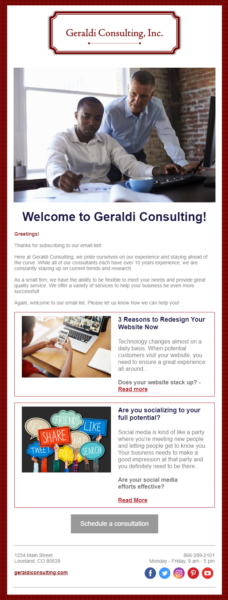
Despite the popularity of social media networks like Facebook and Twitter, an email newsletter is still one of the most effective marketing tools available to small businesses today. Newsletters are an easy and extremely cost-effective way to keep in touch with your clients and potential customers.
Newsletter emails are sent at regular intervals to keep your audience informed about the latest news, happenings, or updates regarding your business. Newsletter emails can be weekly digests of content, quarterly organization updates, or promos for new products. The idea is to maintain an ongoing relationship with your subscribers to keep them connected, engaged and informed.
It’s important to make your newsletter emails stand out from the other emails you send. At Constant Contact, we believe that your email marketing campaigns should always deliver value so that your subscribers look forward to seeing it in their inbox.
Here’s are six tips to help you create and send the perfect newsletter email to your subscribers:
1. Plan in Advance
Before you jump into writing and sending your email newsletter, take some time to do a bit of planning.
What are you trying to accomplish with your newsletter? Of course, you want to communicate with and engage your subscribers. But you need to answer three important questions before you get into the nitty-gritty of building out your newsletter email:
1. How often will be sending the newsletter email?
2. Who is your audience?
3. What type of content will be sharing?
Once you have the answers to these three questions in place, creating your newsletter email will be a breeze.
It’s extremely important to let your subscribers know often they’ll be hearing from you. No one wants to sign up to receive ten emails a day from the same business. When your subscribers sign up, tell them how many emails they can expect and what kind of content you’ll be sharing. Be realistic. If you only have updates to share on a monthly basis, don’t send a weekly newsletter. You want to make sure that you are always providing value and not clutter for your subscribers.
Once you decide on the cadence, stick to it. Make sure you publish on a regular basis so that your audience knows what to expect and when.
Remember to include only relevant content. Don’t be an over-sharer.
You should also keep in mind who your audience is, and what kind of content is interesting to them. You can even segment your contact lists to send relevant content to specific subscribers.
2. Build an email template
Since you will be sending your newsletter email on a regular basis. You will want it to have a consistent look and feel. Pick a template that coincides with the type of content you plan to use. Will you have imagery or videos? Will you be more text-focused? Constant Contact has a variety of newsletter templates from which you can choose that all result in professional-looking emails, with an appropriate balance of white space, and imagery.
Then, customize the template design so that it matches your brand by adding your logos and the colors that you use in your other marketing campaigns. Now that you have a “master template” you won’t need to create a new template every time you send out your newsletter. All you have to do is make a copy of the template and edit the appropriate content blocks.
Also, knowing the template format in advance helps with the content creation process.
3. Curate content
Once you have your template, you are ready to create (or curate) content to fill it in. Do this in advance since it’ll give you a clear idea of just how much content you’re putting in your newsletters and where you need to add images.
Planning your content in advance allows you to decide what content you want to share with your readers on a regular basis. Here are some ideas of what you can use in marketing emails:
- Share expertise via thought-leadership articles and blog posts
- Provide your perspective on industry trends
- Promote new products and give product updates
- Share surveys and ask for feedback
- Feature a staff member bio
- Showcase upcoming events on your calendar
- Highlight results from recent campaigns and activities
- Tell a customer success story
You don’t always need to put in huge amounts of text because let’s be honest, people don’t read that much. Just a simple headline with a couple of lines of text will suffice. You can spice up your newsletter email by including graphics or engaging photography to catch the reader’s eye. Or, to make your newsletter email even more interesting, you could add a behind the scenes video which gives your readers a glimpse into your day-to-day lives.
Don’t try to cram too many things into a single newsletter. Keep in simple and easy to read.
4. Be creative with your subject lines
The typical reader glances at an email for a few seconds before they decide to either read or trash it. The subject line of your newsletter email is the deciding factor and is the most effective way to catch your reader’s eye before they move on to the next email.
How do you entice your subscribers to open your newsletter emails? For starters, make sure your subject lines are not boring. Instead of using a subject line like “March Newsletter” consider tease an intriguing piece of content from within the body of the email.
Next, add a touch of personalization to your subject lines.
Using your reader’s first name in the subject line of your email makes them feel valued. Out of the dozen emails you receive in your inbox daily, the ones that usually catch your eye are the ones that mention your name in the subject line. The same goes for all your readers and customers.

This screenshot is from my personal Gmail inbox, and it is pretty obvious which email stands out amongst the clutter. It’s personalized with my name. And, while technically the email is a monthly newsletter, it’s not been portrayed as one. Although, if you notice, the pre-header text is “Your monthly membership newsletter,” but I still ended up opening the email, not just because it’s from my favorite soccer team, but also since they’re announcing the winners of a contest I participated in.
Another enticing way to encourage email opens is a time-sensitive subject line. Come up with a way to create a sense of urgency. There’s valuable information in your newsletter that needs to be read right away.
5. Use relevant images and videos
When constructing your newsletter email, make sure that you use images and videos to convey your ideas and show your subscribers what you’ve been working on. Imagery is the quickest and most powerful way to give readers an idea about an event you hosted or attended, or a new product launch that’s coming soon.
If your email is inundated with content that will take up too much time to read, a subscriber might skip it, even if it contains useful information.
If you want your readers to engage with your newsletters, it’s important to select images that’ll compel them to read further as pictures and infographics make it easy for people to scan through your content. Include videos in your newsletters whenever possible.
For example, if you are a non-profit that’s hosting a fund-raising and adoption drive for rescue pups, your newsletter email should include images that make a connection with your readers. You could feature images of happy families with their adopted dogs or heartwrenching photos of lonely puppies who haven’t found homes. It is important for the photos to evoke emotion and show them why their support is vital to your organization. Remember to use real images that people can relate to.
People are visual learners. Using images and videos can help people process and retain information better. Don’t be afraid to add these elements to your newsletter.
6. Nail your calls-to-action (CTAs)
While your newsletter may be an informational and less promotional form of communication, it still needs to encourage your audience to act via calls-to-action. Each of your content blocks should include a way for your readers to engage more deeply.
Sharing a blog article? Encourage people to click through to “continue reading.” Are you inviting people to an upcoming event? Ask people to “RSVP.” You get the idea, right? Just remember each of your CTAs needs to be crystal clear.
If you’ve managed to keep your readers engaged until the end of your newsletter email, it’s essential to leave them with a strong call-to-action (CTA) that will tell them how to proceed further.
Not every newsletter email needs to be salesy one. You can encourage your readers to reply to your email, visit your website, connect on social media or even share the email with friends. It will be the easiest part of creating your email and may have the biggest impact in terms of driving real results.
Tell your subscribers what exactly you’d like them to do next without beating around the bush. Make it strong and unambiguous.
Here’s a great example from Geraldi Consulting, Inc. Each of the content blocks has a CTA to “Read more.” In addition, there is a CTA that is placed prominently below the body copy with a bold colored action button telling readers to “Schedule a consultation.”

Don’t let your newsletter email be just another random email
It’s easy to get lost and invest time and money on other marketing efforts, but email still matters and can be just as effective as any other marketing channel.
Give people a reason to sign up for your newsletters and make them want to keep opening your email and consuming your content.
Take the time to plan before you start writing, Don’t be hasty with your subject lines. Use personalized content and phrases that create a sense of urgency in the mind of the reader. Don’t forget to add images and videos you want your readers to see.
Be consistent with your timing and your templates and deliver relevant content. Let your subscribers decide how often they want to hear from you and what topics they want to read about. Remember to close with a compelling call-to-action that tells your readers how to engage.




